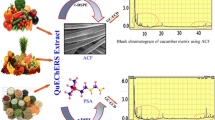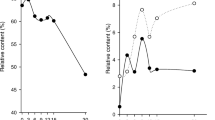Abstract
In this study, the effect of different adsorbents on the reduction of off-flavours within a lentil protein isolate (LPI) was examined by isolating volatile compounds using headspace solid-phase microextraction (HS-SPME), and analysing with gas chromatography–mass spectrometry (GC–MS). LPIs were treated with Amberlite-XAD16N, Amberlite-XAD7HP, Amberlite-XAD4, Sepabeads-SP207 and Diaion-HP20 adsorbents, and then total peak areas of each of the flavour compounds were compared with controls. XAD16N, SP207, and HP20 were able to reduce the levels of aldehydes by 32%, 32%, and 41%, respectively. The aldehyde group of compounds (78% being hexanal) represented the major volatile compound within the LPI. All adsorbents significantly reduced 3,5-octadien-2-one by 61–92%. XAD16N and HP20 were found to be the most effective adsorbents in removing alcohols with decreases of 84% and 80%, respectively. Findings from this study could be integrated into the traditional wet extraction process to produce blander plant protein ingredients.


Similar content being viewed by others

References
Roy F, Boye JI, Simpson BK (2010) Bioactive proteins and peptides in pulse crops: pea, chickpea and lentil. Food Res Int 43(2):432–442
FAO (2018) Production: crops. [Online]. FAOSTAT statistics database. https://faostat.fao.org. Accessed 17 Dec 2018
De Jong GA, Geerdink P, Bussmann PJ, Hylkema N (2015) Economical process for the isolation of functional protein from plants. United States patent application US 14/654,947
Roland WS, Pouvreau L, Curran J, van de Velde F, de Kok PM (2017) Flavor aspects of pulse ingredients. Cereal Chem 94(1):58–65
Azarnia S, Boye JI, Warkentin T, Malcolmson L (2011) Changes in volatile flavour compounds in field pea cultivars as affected by storage conditions. Int J Food Sci Technol 46(11):2408–2419
Bhatty R (1988) Composition and quality of lentil (Lens culinaris Medik): a review. Can Inst Food Sci Technol J 21(2):144–160
Azarnia S, Boye JI, Warkentin T, Malcolmson L (2012) Application of gas chromatography in the analysis of flavour compounds in field peas. Intech Publisher, Rijeka
Jeleń HH, Gracka A (2015) Analysis of black pepper volatiles by solid phase microextraction–gas chromatography: a comparison of terpenes profiles with hydrodistillation. J Chromatogr A 1418:200–209
Jeleń HH, Majcher M, Dziadas M (2012) Microextraction techniques in the analysis of food flavor compounds: a review. Anal Chim Acta 738:13–26
Oomah BD, Liang LS, Balasubramanian P (2007) Volatile compounds of dry beans (Phaseolus vulgaris L.). Plant Foods Hum Nutr 62(4):177–183
Nongonierma A, Voilley A, Cayot P, Le Quéré JL, Springett M (2006) Mechanisms of extraction of aroma compounds from foods, using adsorbents. Effect of various parameters. Food Rev Int 22(1):51–94
Azarnia S, Boye JI, Warkentin T, Malcolmson L, Sabik H, Bellido AS (2011) Volatile flavour profile changes in selected field pea cultivars as affected by crop year and processing. Food Chem 124(1):326–335
Ducki S, Miralles-Garcia J, Zumbé A, Tornero A, Storey DM (2008) Evaluation of solid-phase micro-extraction coupled to gas chromatography–mass spectrometry for the headspace analysis of volatile compounds in cocoa products. Talanta 74(5):1166–1174
Datta A, Grün IU, Kwasniewski MT, Fernando LN (2017) Comparison of two adsorbent based de-bittering procedures for neem (Azadirachta indica A. Juss) tea-effect on polyphenols, anti-oxidant capacity, color and volatile profile. Plant Foods Hum Nutr 72(1):88–95
Filipe-Ribeiro L, Milheiro J, Matos CC, Cosme F, Nunes FM (2017) Reduction of 4-ethylphenol and 4-ethylguaiacol in red wine by activated carbons with different physicochemical characteristics: impact on wine quality. Food Chem 229:242–251
Mishra PK, Tripathi J, Gupta S, Variyar PS (2017) Effect of cooking on aroma profile of red kidney beans (Phaseolus vulgaris) and correlation with sensory quality. Food Chem 215:401–409
Murat C, Gourrat K, Jerosch H, Cayot N (2012) Analytical comparison and sensory representativity of SAFE, SPME, and Purge and Trap extracts of volatile compounds from pea flour. Food Chem 135(3):913–920
Majcher M, Jeleń HH (2009) Comparison of suitability of SPME, SAFE and SDE methods for isolation of flavor compounds from extruded potato snacks. J Food Compos Anal 22(6):606–612
Oomah BD, Razafindrainibe M, Drover JC (2014) Headspace volatile components of Canadian grown low-tannin faba bean (Vicia faba L.) genotypes. J Sci Food Agric 94(3):473–481
Chang C, Stone AK, Green R, Nickerson MT (2019) Reduction of off-flavours and the impact on the functionalities of lentil protein isolate by acetone, ethanol, and isopropanol treatments. Food Chem 277:84–95
Wang Y, Guldiken B, Tulbek M, House JD, Nickerson M (2020) Impact of alcohol washing on the flavour profiles, functionality and protein quality of air classified pea protein enriched flour. Food Res Int 132:109085
Inouye K, Shiihara M, Uno T, Takita T (2002) Deodorization of soybean proteins by enzymatic and physicochemical treatments. J Agric Food Chem 50(6):1652–1658
Cheison SC, Wang Z, Xu SY (2007) Use of macroporous adsorption resin for simultaneous desalting and debittering of whey protein hydrolysates. Int J Food Sci Technol 42(10):1228–1239
Kranz P, Adler P, Kunz B (2011) Investigation of citrus flavor adsorption during debittering of grapefruit juice using kinetic modeling and response surface methodology. Food Sci Biotechnol 20(3):715–724
Ribeiro MH, Silveira D, Ferreira-Dias S (2002) Selective adsorption of limonin and naringin from orange juice to natural and synthetic adsorbents. Eur Food Res Technol 215(6):462–471
Wasswa J, Tang J, Gu XH (2007) Desalting fish skin protein hydrolysates using macroporous adsorption resin. Am J Food Technol 2(5):406–413
Weisz GM, Schneider L, Schweiggert U, Kammerer DR, Carle R (2010) Sustainable sunflower processing—I. Development of a process for the adsorptive decolorization of sunflower [Helianthus annuus L.] protein extracts. Innov Food Sci Emerg Technol 11(4):733–741
AOAC (2003) Official methods of analysis, 17th edn. Association of Official Analytical Chemists, Washington
van den Berg RA, Hoefsloot HC, Westerhuis JA, Smilde AK, van der Werf MJ (2006) Centering, scaling, and transformations: improving the biological information content of metabolomics data. BMC Genomics 7(1):142
Zhang L, Shuai Q, Li P, Zhang Q, Ma F, Zhang W, Ding X (2016) Ion mobility spectrometry fingerprints: a rapid detection technology for adulteration of sesame oil. Food Chem 192:60–66
Murat C, Bard MH, Dhalleine C, Cayot N (2013) Characterisation of odour active compounds along extraction process from pea flour to pea protein extract. Food Res Int 53(1):31–41
Widjaja R, Craske JD, Wootton M (1996) Comparative studies on volatile components of non-fragrant and fragrant rices. J Sci Food Agric 70(2):151–161
Giri A, Osako K, Okamoto A, Ohshima T (2010) Olfactometric characterization of aroma active compounds in fermented fish paste in comparison with fish sauce, fermented soy paste and sauce products. Food Res Int 43(4):1027–1040
Bryant RJ, McClung AM (2011) Volatile profiles of aromatic and non-aromatic rice cultivars using SPME/GC–MS. Food Chem 124(2):501–513
Niu L, Bao J, Zhao L, Zhang Y (2011) Odor properties and volatile compounds analysis of Torreya grandis aril extracts. J Essent Oil Res 23(4):1–6
Pino JA, Marbot R, Vázquez C (2001) Characterization of volatiles in strawberry guava (Psidium cattleianum Sabine) fruit. J Agric Food Chem 49(12):5883–5887
Nielsen GS, Poll L (2004) Determination of odor active aroma compounds in freshly cut leek (Allium ampeloprasum var. Bulga) and in long-term stored frozen unblanched and blanched leek slices by gas chromatography olfactometry analysis. J Agric Food Chem 52(6):1642–1646
Jezussek M, Juliano BO, Schieberle P (2002) Comparison of key aroma compounds in cooked brown rice varieties based on aroma extract dilution analyses. J Agric Food Chem 50(5):1101–1105
Miyazawa M, Nomura M, Marumoto S, Mori K (2013) Characteristic odor components of essential oil from Scutellaria laeteviolacea. J Oleo Sci 62(1):51–56
Guyot-Declerck C, Chevance F, Lermusieau G, Collin S (2000) Optimized extraction procedure for quantifying norisoprenoids in honey and honey food products. J Agric Food Chem 48(12):5850–5855
In MJ, Kim DC, Chae HJ (2005) Downstream process for the production of yeast extract using brewer’s yeast cells. Biotechnol Bioprocess Eng 10(1):85–90
Acknowledgements
Financial support for this research was provided by the Saskatchewan Ministry of Agriculture Development Fund (ADF#: 2015-0273) and the Saskatchewan Pulse Growers (SPCDB: PRO1609).
Author information
Authors and Affiliations
Corresponding author
Ethics declarations
Conflict of interest
The authors declare that there is no conflict of interest.
Compliance with ethics requirements
This article does not contain any studies with human participants or animals performed by any of the author.
Additional information
Publisher's Note
Springer Nature remains neutral with regard to jurisdictional claims in published maps and institutional affiliations.
Rights and permissions
About this article
Cite this article
Guldiken, B., Green, R. & Nickerson, M.T. The impact of different adsorbents on flavour characteristics of a lentil protein isolate. Eur Food Res Technol 247, 593–604 (2021). https://doi.org/10.1007/s00217-020-03648-z
Received:
Revised:
Accepted:
Published:
Issue Date:
DOI: https://doi.org/10.1007/s00217-020-03648-z



